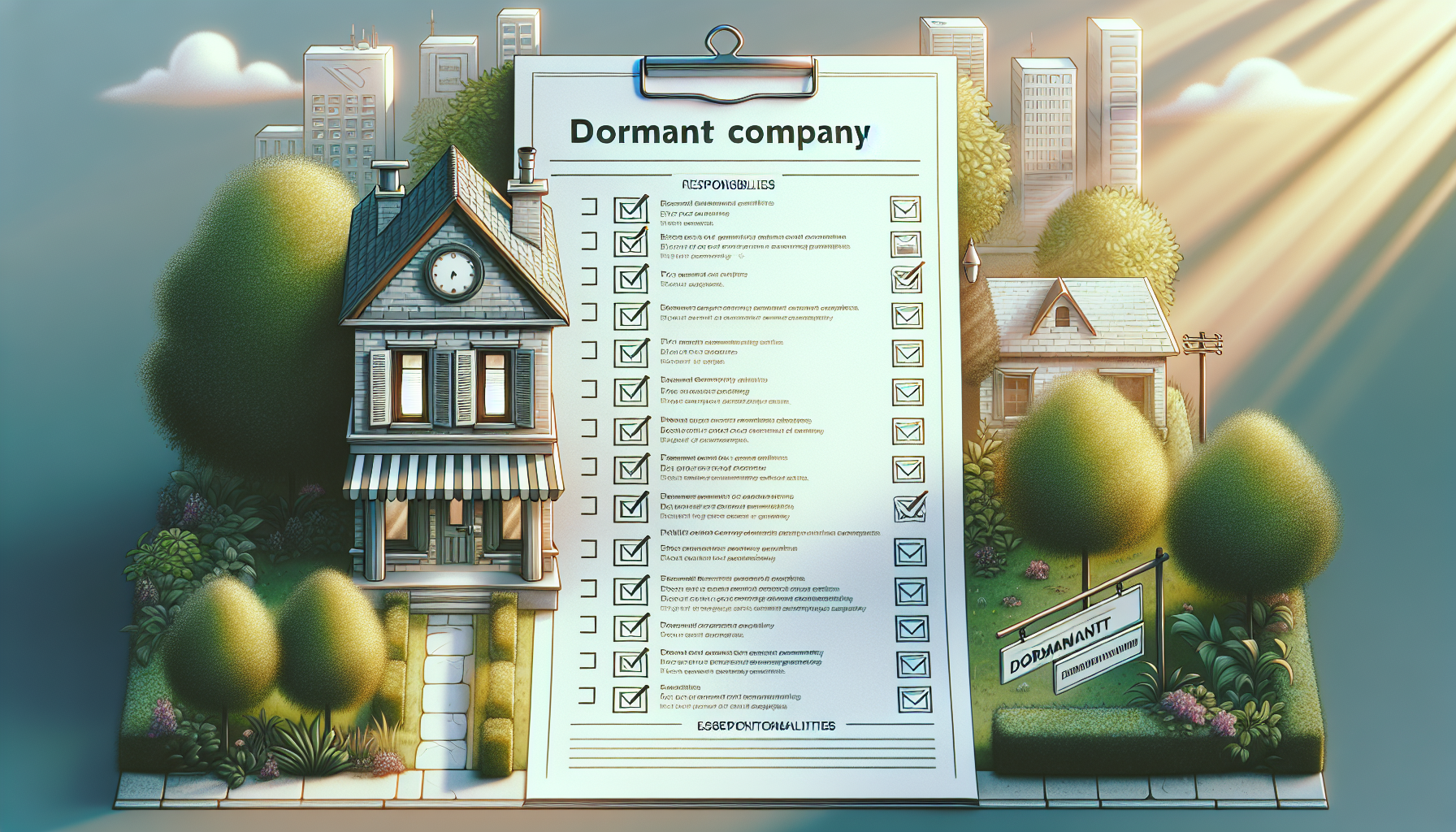CFO GROUP INTEGRATED SERVICES
Understanding Dormant for Corporation Tax: A Practical Guide
CFO Group • October 10, 2024
A company is considered dormant for corporation tax if it has stopped all trading activities and does not earn any income. Dormant companies cannot claim capital allowances or deductions for expenses incurred during their dormant period. This status means the company does not have to pay corporation tax. In this guide, we’ll explore what qualifies a company as dormant, how to declare this status, the responsibilities that come with it, and how to revive a dormant company when needed.
Key Takeaways
- A dormant company, as defined by HMRC, is one that has ceased all trading activities and does not generate any income, allowing it to avoid Corporation Tax.
- Companies must notify HMRC and submit a nil tax return annually to maintain their dormant status, along with fulfilling compliance requirements like filing annual accounts and confirmation statements.
- To revive a dormant company, HMRC must be informed of resumed trading activities within one month, along with fulfilling additional regulatory requirements to ensure compliance.
- A dormant company digital service is available to facilitate the filing of necessary tax forms online without the need for financial statements, ensuring compliance in a simplified manner.
What Does It Mean to Be Dormant for Corporation Tax?
A dormant company, as defined by HMRC, is one that has ceased all trading activities and does not generate any income. If your company stops conducting business transactions and meets specific asset thresholds, it can be considered dormant. This status is crucial as it means the company does not have to pay Corporation Tax.
Activities that would disqualify a company from dormancy include buying or selling goods, renting out property, advertising, employing someone, or earning other income. Knowing what constitutes dormancy is vital, as even minor activities like earning interest can disrupt your dormant status.
For a company to remain dormant, it must not engage in any trading or business activities whatsoever. If your company exceeds the asset thresholds or engages in any of the aforementioned activities, it will no longer qualify as dormant. Hence, maintaining a clear distinction between active and dormant status is key for compliance with HMRC regulations. While dormant companies benefit from lower operational costs, they cannot claim capital allowances or deductions for expenses incurred during their dormant period.
How HMRC Determines Dormant Status
HMRC determines a company’s dormant status based on its trading activities and financial transactions. When a company meets the criteria for dormancy, HMRC may issue an official notification confirming this status. This written communication serves as assurance that the company is not required to file certain tax documents, simplifying compliance for business owners. Informing HMRC about the cessation of trading and the absence of income is necessary to achieve dormant status.
Notifying HMRC is straightforward but must be done meticulously to avoid misunderstandings. For new companies that have not yet received a notice from HMRC, notification can be made via phone instead of filing a return. Keeping HMRC informed ensures that your company remains compliant and avoids unnecessary penalties or complications down the line.
Declaring Your Company Dormant
Declaring a company dormant involves several key steps to ensure compliance and proper notification. First, you must inform HMRC about the change in your company’s trading status, providing details such as the company’s name, Unique Taxpayer Reference, and the date trading ceased. If online notification isn’t feasible, you can inform HMRC via phone or mail.
It’s also important to inform Companies House about your company’s dormant status. The following subsections will guide you through filing a Company Tax Return, deregistering for VAT, and closing the PAYE scheme.
Filing a Company Tax Return
Filing a Company Tax Return is a mandatory step to demonstrate to HMRC that your company is dormant. Even if your company was previously active, you must file company tax returns online to indicate its dormant status. This involves submitting a nil tax return using the ‘File Form for Dormant Companies’ unless HMRC has granted a waiver. This ensures that HMRC has an official record of your company’s dormant period. You can use a dormant company digital service to file the necessary tax forms online, simplifying the compliance process.
Although submitting a nil tax return might seem redundant, it formally acknowledges your company’s non-trading status. This step is crucial to avoid any future disputes or misunderstandings with HMRC.
Make sure the return is filed accurately and on time to maintain compliance and avoid penalties.
Deregistering for VAT
When a company becomes dormant, it must deregister for VAT within a month to avoid penalties. This is required if there are no plans to resume trading. Failing to deregister within this timeframe can result in significant fines and complications with HMRC.
You must submit ‘nil’ VAT returns until deregistration is finalized to complete the process. This ensures that HMRC is aware of your company’s dormant status and that all VAT-related obligations are properly closed off.
Managing VAT deregistration properly is vital for maintaining compliance during dormancy.
Closing PAYE Scheme
If your company is no longer employing anyone during its dormant period, it is necessary to close the PAYE scheme. Notify HMRC to close the scheme if you do not plan to employ anyone within the current tax year. This step ensures that HMRC does not expect any payroll submissions from your company.
Informing HMRC that there will be no further employment activity within the current tax year is necessary to close the PAYE scheme. This is a crucial step to avoid unnecessary paperwork and potential penalties.
Closing the PAYE scheme properly simplifies the maintenance of your company’s dormant status.
Responsibilities of Dormant Companies
Even in dormancy, companies have responsibilities to uphold. All limited companies, including dormant ones, are required to submit annual accounts and a confirmation statement to Companies House each year. This keeps the company’s financial status and details transparent and up-to-date. Non-compliance with these responsibilities can lead to penalties or even the company’s dissolution.
The following subsections will delve into the specifics of annual accounts, confirmation statements, and corporate income tax return for dormant companies.
Annual Accounts and Confirmation Statements
Dormant companies must still file annual accounts and a confirmation statement to maintain compliance. The annual accounts must be submitted to Companies House within nine months following the company’s financial year-end. These accounts provide a snapshot of the company’s financial position, even if no trading activity has occurred.
In addition to annual accounts, a confirmation statement must be submitted annually. This statement confirms that the company’s details remain accurate and up-to-date. Dormant companies can file their confirmation statement online for a fee of £13.
In addition to annual accounts, a confirmation statement must be submitted annually. This statement confirms that the company’s details remain accurate and up-to-date. Dormant companies can file their confirmation statement online for a fee of £13.
Tax Returns for Dormant Companies
Dormant companies are required to submit a nil tax return unless they qualify for a specific exemption. After notifying HMRC of a dormant status, no further Company Tax Returns are required unless trading resumes or HMRC requests it. This reduces the administrative burden significantly compared to active companies. However, dormant companies cannot claim capital allowances or deductions for expenses incurred during their dormant period.
HMRC evaluates a company’s trading activity to determine its dormant status, focusing on whether there have been significant accounting transactions during the reporting period. While dormant, companies must still submit nil tax returns to remain in good standing. Managing these filings properly ensures that the company maintains its dormant status and avoids penalties.
Corporation Tax Implications
A dormant company is still required to file a corporation tax return (CT600) and pay corporation tax on any profits made. Corporation tax is a tax on the profits of a company, and dormant companies are not exempt from this tax. HMRC may still send a letter to a dormant company reminding them of the corporation tax due date for the period. The corporation tax due date is typically 9 months and 1 day after the end of the accounting period.
Dormant companies may be eligible for a reduced corporation tax rate, depending on the company’s circumstances. It is essential to keep accurate records and file the corporation tax return on time to avoid penalties and interest charges. Failure to file a corporation tax return or pay corporation tax can result in fines and penalties, which can be costly for dormant companies.
In addition to corporation tax, dormant companies may also be required to pay other taxes, such as value-added tax (VAT) or services tax, if they have any other income. It is crucial to understand the tax implications of being a dormant company and to seek professional advice if necessary.
Reviving a Dormant Company
Reviving a dormant company involves notifying HMRC and registering for Corporation Tax once again. This process is necessary when the dormant company recommences business or begins to receive any income.
The following subsections will guide you through notifying HMRC and meeting additional requirements for revival.
Notifying HMRC
The first step to revive a dormant company is to notify HMRC within one month of resuming business activity or receiving income. This notification should also be sent to Companies House. Failing to notify HMRC can lead to penalties and complications.
To notify HMRC, you must submit an email with specific details regarding the resumption of business activities. This ensures that HMRC is aware of your company’s change in status and can update their records accordingly. Notifying HMRC properly is crucial to avoid any future issues.
Additional Requirements for Revival
Reviving a dormant company involves meeting additional requirements to ensure compliance. One such requirement is passing the shareholding test. This test verifies that the company meets certain ownership criteria, which is essential for maintaining corporate governance standards.
Another requirement is the assignment of an ‘Approver’ who will handle corporate tax matters for the company. This individual ensures that all tax obligations are met and that the company remains compliant with HMRC regulations. Meeting these additional requirements ensures a smooth transition from dormant to active status.
Benefits and Drawbacks of Maintaining a Dormant Company
Keeping a dormant company has its own set of benefits and drawbacks. While it can lead to significant cost savings, there are still compliance responsibilities that must be upheld.
The following subsections will explore the cost-saving benefits and the compliance responsibilities of maintaining a dormant company.
Cost Savings
Maintaining a dormant company offers significant cost savings. This is a primary benefit. Dormant companies often incur lower administrative costs due to simplified accounting and tax computation requirements. Additionally, certain regulations may allow dormant companies to qualify for waivers, further reducing maintenance costs. Furthermore, it is essential to ensure that dormant company accounts are filed correctly to maintain compliance.
These cost savings can be substantial, especially for companies that plan to remain dormant for extended periods. Minimizing financial and administrative activities allows dormant companies to manage expenses while maintaining compliance.
Compliance Responsibilities
Despite the cost savings, dormant companies must still prepare financial statements and annual filings to meet compliance requirements. Filing tax returns, even when qualifying as dormant, is crucial to avoid penalties. Neglecting these responsibilities can result in financial penalties and possible loss of dormant status.
Dormant companies may benefit from regulatory waivers that further limit maintenance expenses. However, staying vigilant and meeting all compliance obligations is crucial to maintain good standing with the corporate regulatory authority.
Best Practices for Managing Dormant Companies
Managing a dormant company requires careful attention to detail and compliance with regulatory requirements. Here are some best practices for managing dormant companies:
- File Dormant Company Accounts: Dormant companies are required to file dormant company accounts with Companies House. This includes a balance sheet and a profit and loss account.
- File Company Tax Returns: Dormant companies are required to file a corporation tax return (CT600) with HMRC, even if they have no profits to report.
- Pay Corporation Tax: Dormant companies are required to pay corporation tax on any profits made.
- Keep Accurate Records: It is essential to keep accurate records of all financial transactions, including invoices, receipts, and bank statements.
- Notify HMRC and Companies House: If a dormant company recommences business, it is essential to notify HMRC and Companies House.
- Seek Professional Advice: If you are unsure about any aspect of managing a dormant company, it is essential to seek professional advice from an accountant or tax advisor.
By following these best practices, dormant companies can ensure compliance with regulatory requirements and avoid penalties and fines.

Closing a Dormant Company
Closing a dormant company involves meeting specific criteria and following a structured process. The company must be solvent and able to meet its liabilities. Ensuring the company can meet its liabilities is necessary before proceeding with closure.
The following subsection will guide you through the striking off process.
Striking Off Process
The company must clear all its liabilities to be eligible for striking off. Additionally, it must obtain consent from its members. This involves ensuring that the company has no outstanding debts or obligations. Consent from the company’s members is typically obtained through a resolution or written agreement.
Once all liabilities are cleared and consent is obtained, the striking off application can be submitted to the relevant regulatory authority. This process marks the official closure of the dormant company, ensuring that it is removed from the Companies House register.
Following the striking off process properly helps avoid future legal or financial complications.
Common Mistakes to Avoid
One common mistake that companies often make is overlooking the requirement to file Form C-S for dormant status, even if they believe they are exempt. Filing applications for waivers incorrectly can also result in automatic rejections, which many companies fail to anticipate. Additionally, it’s crucial to ensure that a dormant company does not hold investments that generate income, as this can compromise its dormant status.
Another frequent mistake is not settling all liabilities before proceeding with the closure of the company. Obtaining approval from all company members is a mandatory step in the striking off process. Neglecting these steps can lead to significant delays and potential legal issues.
Accurately completing and submitting all necessary documentation on time is essential for maintaining compliance and avoiding penalties.
Summary
In summary, understanding and managing a dormant company involves several critical steps and responsibilities. From declaring your company dormant and filing necessary documents to maintaining compliance and potentially reviving or closing the company, each step requires careful attention to detail. Properly managing these processes ensures that your company remains in good standing with HMRC and Companies House, avoiding unnecessary penalties and complications.
Maintaining a dormant company can offer significant cost savings and simplified administrative duties, but it also comes with compliance responsibilities that must be upheld. By staying informed and proactive, you can navigate the complexities of corporation tax and make informed decisions for your business’s future. Whether you choose to maintain, revive, or close your dormant company, understanding the requirements and best practices will help you achieve your business goals more effectively.
Simplify Your Dormant Company Management with CFO ACC SG
Navigating the complexities of managing a dormant company can be challenging. At CFO ACC SG, we make it easy for you to stay compliant with HMRC regulations and avoid costly mistakes.
Why Choose CFO ACC SG?
- Compliance Made Simple: We’ll help you file all necessary documents, including dormant tax returns and annual accounts, on time.
- Expert Guidance: Get tailored advice to maintain your dormant status or revive your company when needed.
- Hassle-Free Service: From striking off to reactivating your company, we’ll guide you every step of the way.
Don’t let compliance slip—Contact CFO ACC SG today to ensure your dormant company stays in good standing with HMRC!
Frequently Asked Questions
What qualifies a company as dormant for Corporation Tax purposes?
A company qualifies as dormant for Corporation Tax purposes if it has ceased all trading activities and does not generate any income. This classification typically applies when the company is not active in any business operations.
How do I notify HMRC that my company is dormant?
To notify HMRC that your company is dormant, you must inform them of the cessation of trading and absence of income, including your company's name, Unique Taxpayer Reference, and the date trading ceased.
What are the ongoing responsibilities of a dormant company?
A dormant company must submit annual accounts and a confirmation statement to Companies House each year, and it may also need to file nil tax returns. Ensuring compliance with these requirements is essential to maintain its dormant status.
How can I revive a dormant company?
To successfully revive a dormant company, you should notify HMRC about its restart and re-register for Corporation Tax through your business tax account. This step is essential for compliance and resuming business operations.
What are the common mistakes to avoid when managing a dormant company?
To effectively manage a dormant company, it is essential to avoid common mistakes such as failing to file Form C-S, incorrectly submitting waiver applications, neglecting to settle all liabilities prior to closure, and overlooking the need for member consent for striking off. Addressing these issues will ensure compliance and a smoother management process.













